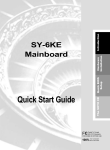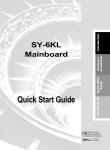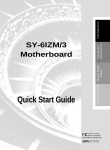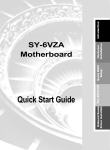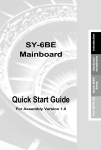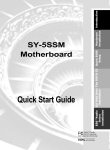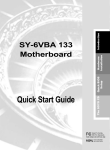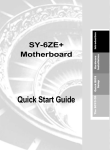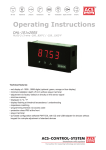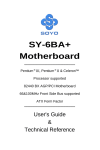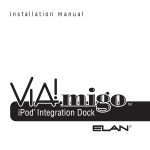Download SOYO SY-V6BE+ User's Manual
Transcript
Quick Start Guide The SOYO CD Quick BIOS Setup Hardware Installation Introduction SY-V6BE+ Mainboard SOYO ™ SY-V6BE+ Mainboard Pentium ® II processor & CeleronTM processors AGP/PCI Mainboard 66&100MHz Front Side Bus supported ATX Form Factor Copyright © 1998 by Soyo Computer Inc. Trademarks: Soyo is a registered trademark of Soyo Computer Inc. All trademarks are the property of their owners. Product Rights: Product and corporate names mentioned in this publication are used for identification purposes only and may be registered trademarks or copyrights of their respective companies. Copyright Notice: All rights reserved. This manual is copyrighted by Soyo Computer Inc. You may not reproduce, transmit, transcribe, store in a retrieval system, or translate into any language, in any form or by any means, electronic, mechanical, magnetic, optical, chemical, manual or otherwise, any part of this publication without express written permission of Soyo Computer Inc. Disclaimer: Soyo Computer Inc. makes no representations or warranties regarding the contents of this manual. We reserve the right to revise the manual or make changes in the specifications of the product described within it at any time without notice and without obligation to notify any person of such revision or change. The information contained in this manual is provided for general use by our customers. Our customers should be aware that the personal computer field is the subject of many patents. Our customers should ensure that their use of our products does not infringe upon any patents. It is the policy of Soyo Computer Inc. to respect the valid patent rights of third parties and not to infringe upon or assist others to infringe upon such rights. Restricted Rights Legend: Use, duplication, or disclosure by the Government is subject to restrictions set forth in subparagraph (c)(1)(ii) of the Rights in Technical Data and Computer Software clause at 252.277-7013. About This Guide: This Quick Start Guide is for assisting system manufacturers and end users in setting up and installing the mainboard. Information in this guide has been carefully checked for reliability; however, no guarantee is given as to the correctness of the contents. The information in this document is subject to change without notice. If you need any further information, please visit our Web Site on the Internet. The address is "http://www.soyo.com.tw". SY-V6BE+ Serial - Version 1.0 - Edition: November 1998 * These specifications are subject to change without notice 2 SY-V6BE+ Quick Start Guide 1 Introduction This guide is designed for all users to provide the basic steps of mainboard setting and operation. For further information, please refer to SY-V6BE+ Mainboard User's Guide and Technical Reference online manual included on the CD-ROM packed with your mainboard. Unpacking * If your board comes with a driver disc and a paper manual, the Quick Start Guide and the CD-ROM are not included in the package. When unpacking the mainboard, check for the following items: u The SY-V6BE+ AGP/PCI Mainboard u This Quick Start Guide u The Installation CD-ROM u The CPU Retention Set u One IDE Device Flat Cable u One Floppy Disk Drive Flat Cable 3 Introduction Congratulations on your purchase of the SY-V6BE+ Mainboard. This Quick Start Guide describes the steps for installing and setting up your new mainboard. SY-V6BE+ Quick Start Guide SY-V6BE+ Mainboard Layout PS/2 KB Connector PS/2 Mouse Connector JP10 USB 2 1 Slot 1 for Pentium II Processor CPUFAN FDC PRT COM 1 1 COM 2 ATX Power 1 AGP Slot Ultra I/O Chipset 1 IDE 2 IDE 1 3V Lithium Battery PCI Slot #1 SW1 1 IR1 5 PCI Slot #2 JP5 JP44 Wake on LAN 3 1 1 BIOS Flash Introduction USB 1 DIMM 1 DIMM 2 DIMM 3 3 1 3 PCI Slot #3 PCI Slot #4 _ Hardware Monitoring ISA Slot #1 Speaker ISA Slot #2 Keylock + Winbond W83781D ISA Slot #3 _ HDD LED + _ Turbo + LED PWRBT _ Power LED + Reset 1 CHAFAN Key Features Ø Ø Ø Ø Ø Ø Supports Intel Pentium® II processor (233500MHz) & CeleronTM processors (266400MHz) Auto-detect CPU voltage PC98, ACPI, Ultra DMA/33MHz Power-on by modem, alarm or keyboard SOYO COMBO Setup Supports Wake-On-LAN (WOL) Ø Ø Ø Ø Ø Ø Ø 4 Supports onboard hardware monitoring and includes Hardware Doctor ™ utility (optional) S1 x 32-bit AGP slot 4 x 32-bit bus mastering PCI slots 2 x USB ports onboard 1 x IrDA port Supports multiple-boot function DMI utility SY-V6BE+ Quick Start Guide 2 Installation l Before handling the mainboard, ground yourself by grasping an unpainted portion of the system's metal chassis. l Remove the mainboard from its anti-static packaging. Hold it by the edges and avoid touching its components. l Check the mainboard for damage. If any chip appears loose, press carefully to seat it firmly in its socket. Follow the directions in this section designed to guide you through a quick and correct installation of your new SY-V6BE+ Mainboard. For detailed information, please refer to SYV6BE+ Mainboard User's guide and Technical Reference online manual included on the CD-ROM packed with your mainboard. PREPARATIONS Gather and prepare all the necessary hardware equipment to complete the installation successfully: u Pentium® II processor with built-in CPU cooling fan (boxed type) u SDRAM module u Computer case and chassis with adequate power supply unit u Monitor u PS/2 Keyboard u Pointing Device (PS/2 mouse) u VGA Card u Sound Card (optional) u Speaker(s) (optional) u Disk Drives: HDD, CD-ROM, Floppy drive … u External Peripherals: Printer, Plotter, and Modem- (optional) u Internal Peripherals: Modem and LAN cards (optional) 5 Hardware Installation To avoid damage to your mainboard, follow these simple rules while handling this equipment: SY-V6BE+ Quick Start Guide Install the Mainboard Follow the steps below in order to perform the installation of your new SY-V6BE+ Mainboard. Step 1. Install the CPU Mark your CPU Frequency: Record the working frequency of your CPU that should be clearly marked on the CPU cover. 233MHz (66 x 3.5) 266MHz (66 x 4.0) 300MHz (66 x 4.5) 333MHz (66 x 5.0) 350MHz (100 x 3.5) 400MHz (100 x 4.0) 450MHz (100 x 4.5) 500MHz (100 x 5.0) CPU Mount Procedure: To mount the Pentium® II processor that you have purchased separately, follow these instructions. 1 Unpack the Retention Kit 2 Position the Mainboard 3 Insert the Screws 4 Install the Supporting Base Hardware Installation ATX Power Supporting Base Slot 1 Support Clip Latches (x2) Heat Sink Screws (x2) CPUFAN Power Retention Clip 5 Install the Retention Clip 7 Install the Support Clip Larger Pinhole 6 8 Install the CPU Insert the Latches 9 Remember to connect the CPU Cooling Fan to the CPUFAN power connector on the mainboard. 6 SY-V6BE+ Quick Start Guide Step 2. Make Connections to the Mainboard This section tells how to connect internal peripherals and power supply to the mainboard. Internal peripherals include IDE devices (HDD, CD-ROM), Floppy Disk Drive, Chassis Fan, Front Panel Devices (Turbo LED, Internal Speaker, Reset Button, IDE LED, and KeyLock Switch.), Wake-On-LAN card, VGA card, Sound Card, and other devices. For more details on how to connect internal and external peripherals to your new SY-V6BE+ Mainboard, please refer to SY-V6BE+ Mainboard User's Guide and Technical Reference online manual on CD-ROM. IrDA (Infrared Device Header): IR1 Pin1 Pin2 Pin3 Pin4 Pin5 VCC None IRRX GND IRTX CPU Cooling Fan: CPUFAN Pin1 Pin2 Pin3 GND 12V SENSOR Power LED Key Lock 1 1 1 1 1 1 Reset PWRBT Turbo LED HDD LED HDD LED Pine1 Pin2 LED LED Anode Cathode Chassis Fan: CHAFAN Pin1 Pin2 Pin3 GND 12V SENSOR Power LED Keylock Pin1 Pin2 Pin1 Pin2 Pin3 GND 5V NC GND Control Pin Speaker Pin1 Pin2 Pin3 Pin4 5V NC NC Speaker out Speaker 1 Wake-On-LAN Header: JP44 Pin1 Pin2 Pin3 5VSB GND MP-Wakeup Turbo LED Pin1 Pin2 LED GND Cathode PWRBT Pin1 Pin2 Power Good GND RESET Pin1 Pin2 Power GND On/Off ATX Power On/Off: PWRBT ATX Power Supply: ATX PW Connect your power switch to this header (momentary switch type). To turn off the system, please press this switch and hold down for longer than 4 seconds. Attach the ATX Power cable to this connector. When using the Power-On by PS/2 Keyboard function, please make sure the ATX power supply can take at least 720mA load on the 5V Standby lead (5VSB) to meet the standard ATX specifications. 7 Hardware Installation Connectors and Plug-ins SY-V6BE+ Quick Start Guide Configure Memory Your board comes with three DIMM sockets, providing support for up to 768MB of main memory using DIMM modules from 8MB to 256MB. For 66MHz front side bus CPUs use 12ns or faster memory; for 100MHz front side bus CPUs use 8ns (100MHz, PC100 compliant) memory. Step 3. Memory Configuration Table Number of Memory Modules DIMM 1 DIMM 2 DIMM 3 1st 1 2 3rd Hardware Installation 3 RAM Type Memory Module Size (MB) 2nd 1st 2nd 1st SDRAM 8/16/32/64/128/256 Mbytes Note:(1) 256 MB memory modules only available on PC registered DIMM. (2) Always install memory modules in the order prescribed in this table. (3) Do not install unbuffered and registered memory modules together. Important: It is of prime importance that you install DIMM modules as outlined in the table above in order to preserve signal integrity on 100MHz front side bus systems. Step 4. Set SW1 for power up FSB clock and AGP bus clock. SW1 is used to adjust AGP bus clock frequency depending on the value of the front side bus (FSB) clock, also the setting of the SW1 determines the power up FSB clock which will remain effective until the BIOS set the FSB clock to the CMOS setting. SW1 Setting Power up FSB Clock AGP Clock AGP Clock 66MHz = FSB Clock ÷ 1 AGP Clock 100MHz = FSB Clock ÷ 1.5 Note: The specification of maximum AGP bus Clock frequency is 66.6MHz. Set SW1 to open when you use a FSB 100MHz CPU such as 350MHz, 400MHz, 450MHz , or 500MHz. Set SW1 to close when you use a FSB 66MHz CPU such as 233MHz, 266MHz, 300MHz, 333MHz , or 366Mhz only for Celeron. Set SW1 to open when you use a FSB 66MHz but want to over clock the FSB clock to 100MHz via the BIOS setting. ∗ ∗ ∗ 8 SY-V6BE+ Quick Start Guide Set the CPU Frequency This mainboard does not use any jumpers to set the CPU frequency, CPU setting are changed through the BIOS [SOYO COMBO SETUP]. Refer to Chapter 3 “Quick BIOS Setup”for details on how to set the Pentium II processor frequency. Step 5. Step 6. Enable/Disable Power-On by Keyboard (JP10) Power-On by Keyboard Enable Disable JP10 Setting Short pin 1-2 to enable the Power-On by Keyboard function. Short pin 2-3 to disable the Power-On by Keyboard function. 1 2 3 1 2 3 Important: When using the Power-On by Keyboard function, please make sure the ATX power supply can take at least take 720mA load on the 5V standby lead (5VSB) to meet the standard ATX specification. Apart from the jumper setting, you have to enter the CMOS setup and set the “Power-On by Keyboard” item in the SOYO COMBO Setup to “Password” or function key. Step 7. Clear CMOS Data (JP5) Clear the CMOS memory by momentarily shorting pin 2-3 on jumper JP5 for at least 5 seconds, and then by shorting pin 1-2 to retain new settings. This jumper can be easily identified by its white colored cap. CMOS Clearing JP5 Setting Clear CMOS Data Short pin 2-3 for at least 5 seconds to clear the CMOS. 1 2 3 Retain CMOS Data Short pin 1-2 to retain the 1 2 3 new settings. Note: You must unplug the ATX power cable from the ATX power connector when performing the CMOS Clear operation. You MUST enter the CMOS SETUP and SAVE CMOS setting twice after clearing CMOS data. If you fail to do this your new setting would NOT be Saved. 9 Hardware Installation You can choose to enable the Power-On by Keyboard function by shorting pin 1-2 on jumper JP10, otherwise, short pin 2-3 to disable this function. SY-V6BE+ Quick Start Guide Note on Over-clocking Capability Hardware Installation The SY-V6BE+ mainboard provides over-clocking capability. Due to the over-clocking setting your system may fail to boot up or hang during run time. If this occurs, please perform the following steps to recover your system from the abnormal situation: 1. Turn off system power (If you use a ATX power supply, sometimes you have to press the power button for more then 4 seconds to shut down the system) 2. Set the SW1 to short if you use a FSB 66MHz CPU, Set the SW1 to open if you use a FSB 100MHz CPU 3. Press and hold down the <Insert> key while turning on the system power. Keep holding down the <Insert> key until you see the message of the CPU type and frequency (133MHz or 200MHz) appear on screen 4. Press the <Del> key during the system diagnostic checks to enter the Award BIOS Setup program 5. From the BIOS main menu, select [SOYO COMBO] and move the cursor to the [CPU Frequency] field to set the proper working frequency 6. Select [Save & Exit SETUP] and press <Enter> to save the configuration to the CMOS memory, and continue the boot sequence Note: SOYO does not guarantee system stability if the user over clocks the system. Any malfunctions due to over-clocking are not covered by the warranty. 10 SY-V6BE+ Quick Start Guide 3 Quick BIOS Setup This mainboard does not use any hardware jumpers to set the CPU frequency. Instead, CPU settings are software configurable with the BIOS [SOYO COMBO SETUP]. The [SOYO COMBO SETUP] menu combines the main parameters that you need to configure, all in one menu, for a quick setup in BIOS. After the hardware installation is complete, turn the power switch on, then press the <DEL> key during the system diagnostic checks to enter the Award BIOS Setup program. The CMOS SETUP UTILITY will display on screen. Then, follow these steps to configure the CPU settings. Select [STANDARD CMOS SETUP] Set [Date/Time] and [Floppy drive type], then set [Hard Disk Type] to “Auto”. Step 2. Select [LOAD SETUP DEFAULT] Select the “LOAD SETUP DEFAULT”menu and type “Y”at the prompt to load the BIOS optimal setup. Step 3. Select [SOYO COMBO SETUP] Move the cursor to the [CPU Frequency] field to set the CPU frequency. Available [CPU Frequency] settings on your SY-V6BE+ Mainboard are detailed in the following table. If you set this field to [Manual], you are then required to fill in the next two consecutive fields: (1) the CPU Host/PCI Clock, and (2) the CPU Ratio. CPU Frequency 233MHz (66 x 3.5) 400MHz (100 x 4.0) 266MHz (66 x 4.0) 450MHz (100 x 4.5) 300MHz (66 x 4.5) 500MHz (100 x 5.0) 333MHz (66 x 5.0) Select the working frequency of your Pentium® II processor among these preset values. Note: Mark the checkbox that corresponds to the working frequency of your Pentium® II processor in case the CMOS configuration should be lost. 350MHz (100 x 3.5) Note: if you use Bus Frequencies of 75 MHz, make sure that your PCI cards can cope with the higher PCI clock. Select [SAVE & EXIT SETUP] Press <Enter> to save the new configuration to the CMOS memory, and continue the boot sequence. Step 4. 11 Hardware Installation Step 1. SY-V6BE+ Quick Start Guide 4 The SOYO CD Your SY-V6BE+ Mainboard comes with a CD-ROM labeled "SOYO CD." The SOYO CD contains the user's manual file for your new mainboard, the drivers software available for installation, and a database in HTML format with information on SOYO mainboards and other products. Step 1. Insert the SOYO CD into the CD-ROM drive The SOYO CD The SOYO CD will auto-run, and the SOYO CD Start Up Menu will display as shown below. (SOYO CD Start Up Program Menu) The SOYO CD Start Up Program automatically detects which SOYO mainboard you own and displays the corresponding model name. Step 2. Read SOYO [model name] Manual Click the Read Manual button to open the user's manual file of your mainboard. 12 SY-V6BE+ Quick Start Guide Please note that if the Start Up program was unable to determine which SOYO mainboard you own, the manual selection menu will pop up, as shown below. Then select the user's manual file that corresponds to your mainboard model name and click OK. SOYO CD Manuals Please select your manual In the box below and click OK. SY-V6BE+ OK Back (Manual Selection Menu) Note: The Start Up program automatically detects if the Acrobat Reader utility is already present in your system, and otherwise prompts you on whether or not you want to install it. You must install the Acrobat Reader utility to be able to read the user's manual file. Follow the instructions on your screen during installation, then once the installation is completed, restart your system and re-run the SOYO CD. Step 3. Install Drivers The following describes the best way of installing Windows 95 or Windows 98 on your SY-V6BE+ mainboard: Ø The following BIOS default settings should not be changed: 1. The ‘OnChip USB Controller’item under ‘BIOS features Setup’is set to enabled. 2. The ‘USB Assigned IRQ’item under ‘PnP/PCI Configuration is set to enabled. You MUST have these two items enabled for Windows 95/98 to run properly on your system. Ø Install Windows 95/98 Ø After installation of windows, you will need to install theVIA drivers. Follow the instruction below. 13 The SOYO CD The user's manual files included on the SOYO CD can be read in PDF (Postscript Document) format. In order to read a PDF file, the appropriate Acrobat Reader software must be installed in your system. SY-V6BE+ Quick Start Guide Click the Install Drivers button to display the list of drivers that can be installed on your mainboard. The start-up program displays the drivers available for the SY-V6BE+ and the Windows version you use. For Windows 95 four drivers will be listed (see ‘Driver Installation Menu’below), for Windows 98 three drivers will be listed (the ACPI drivers will be left out). If you want to see all the drivers available on the SOYO –CD, click the Display all drivers on the SOYO CD button. Do NOT install drivers that are not suitable for you board, otherwise your system may crash. Driver Installation Please select the driver you want to install and click OK, You will have to restart your system after installation. Only the drivers that are relevant to your board are displayed initially. VIA IRQ remapping utility VIA ACPI Driver SOYO SpeedPro BusMaster Driver VIA VxD Driver The SOYO CD Cancel Display all drivers on the SOYO CD OK (Driver Installation Menu) Select which driver you want to install and click OK, or click Cancel to return to the main menu. When the installation program of a driver starts running the SOYO-CD will exit. After finishing the installation, restart the SOYO-CD and install the next driver. We recommend you to install all drivers, and to do so in the right sequence (top to bottom). Note: Once you have selected a driver, the system will automatically exit the SOYO CD to begin the driver installation program. When the installation is complete, most drivers require to restart your system before they can become active. Install the drivers in sequence, starting with the VIA IRQ remapping utility. After installing all drivers above, if you use Windows 95, first install the USB supplement before installing the AGP driver that came with your AGP card. 14 SY-V6BE+ Quick Start Guide The USB supplement is available on the Windows OSR 2 or above CD in the following directory:\OSR2\usbsupp.exe It also can be downloaded from www.microsoft.com Step 4. Enter the SOYO CD Click the Enter SOYO CD button to enter the SOYO HTML database. The Start Up program will activate the default HTML browser installed on your system (for example, Internet Explorer or Netscape) to visualize the contents of the SOYO CD. (SOYO CD HTML Database in English*) (* The list of menu options may vary between languages) Note: If no HTML browser is installed on your system, the Start Up program will prompt you on whether or not you would like to install the Internet Explorer* browser. Click YES to install the HTML browser. After the installation is complete, please restart your system. Then re-run the SOYO CD and you will be able to browse the SOYO HTML database. (* Internet Explorer is a Microsoft Trademark) 15 The SOYO CD The SOYO CD contains useful information about your Mainboard and other SOYO products available in as many as eleven different languages. For your convenience, this information is available in HTML format, similar to the format widely used on the Internet. Edition: November 1998 Version 1.0 SY-V6BE+ SERIAL International Headquarters Soyo Computer Inc., (Taiwan) Tel: 886-2-2290-3300 Fax: 886-2-2298-3322 Web Site: http://www.soyo.com.tw E-mail: [email protected] USA Branch Office Soyo Tek Inc., (USA) Tel: (408) 452-7696 Fax: (408) 573-7696 Web Site: http://www.soyousa.com E-mail: [email protected] SOYO Europe Soyo Europe B.V., (Holland) Tel: 31-79-3637500 Fax: 31-79-3637575 Web Site: http://www.soyo-europe.com http://www.soyo.nl E-mail: [email protected] Germany Branch Office SAAT Technology GmbH, (Germany) Tel: 49-(0)444-204044 Fax: 49-(0)444-203422 Web Sites:http://www.saat.de http://www.soyo-saat.de http://www.soyo-saat.com Email: [email protected] UK Branch Office Soyo (U.K.) Ltd. Tel: 44-(0)181-569 4111 Fax: 44-(0)181-569 4134 Web Site: http://www.soyo.nl E-mail: [email protected] Japan Branch Office Soyo Computer (Japan) Tel: 81-3-33682188 Fax: 81-3-33682199 Web Site: http://www.soyo.co.jp E-mail: [email protected] Hong Kong Branch Office Soyo Hong Kong Ltd. (H.K.) Tel: 852-2710-9810 Fax: 852-2710-9078 Web Site: http://www.soyo.com.hk E-mail: [email protected]
















